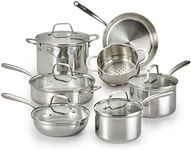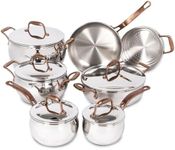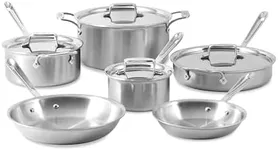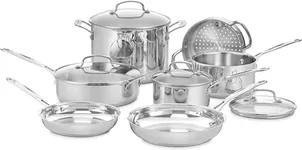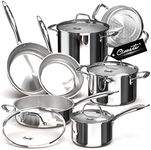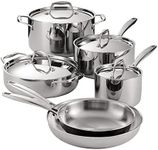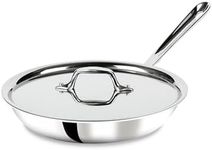Buying Guide for the Best Stainless Steel Cookwares
Choosing the right stainless steel cookware can make a big difference in your cooking experience. Stainless steel is popular because it’s durable, non-reactive, and easy to maintain. However, not all stainless steel cookware is the same. To find the best fit for your kitchen, it’s important to understand the key features and how they relate to your cooking habits and needs. By focusing on the main specifications, you can select cookware that will serve you well for years to come.Stainless Steel GradeThe grade of stainless steel refers to the composition of metals used in the cookware, which affects its resistance to rust, corrosion, and staining. The most common grades are 18/10, 18/8, and 18/0, where the first number is the percentage of chromium and the second is nickel. Higher nickel content (like 18/10) means better resistance to rust and a shinier finish. If you want cookware that stays looking new and resists corrosion, look for higher grades. If you have a nickel allergy or want a more affordable option, lower grades like 18/0 may be suitable, but they may not be as durable.
Ply ConstructionPly construction refers to how many layers of metal are bonded together in the cookware. Common types are single-ply, tri-ply (three layers), and multi-ply (five or more layers). More layers usually mean better heat distribution and retention, which helps prevent hot spots and burning. If you do a lot of precise cooking or want even heating, tri-ply or multi-ply cookware is a good choice. For basic boiling or simple tasks, single-ply may be enough, but it won’t heat as evenly.
Core MaterialThe core material is the metal sandwiched between layers of stainless steel, often aluminum or copper. This core helps with heat conduction, as stainless steel alone is not a great heat conductor. Aluminum cores are common and provide good, even heating at a reasonable price. Copper cores offer even better heat control but are usually more expensive. If you want fast, responsive heating for tasks like sautéing or making sauces, look for cookware with a copper or thick aluminum core. For general cooking, an aluminum core is usually sufficient.
Handle Design and MaterialHandles can be made from stainless steel, silicone, or other materials, and their design affects comfort and safety. Stainless steel handles are durable and oven-safe, but they can get hot. Silicone-wrapped handles stay cooler but may not be oven-safe at high temperatures. If you often move pans from stovetop to oven, choose all-metal handles. For stovetop-only use, comfort and cool-touch features may be more important.
Lid TypeLids can be made of stainless steel or glass. Stainless steel lids are durable and oven-safe, while glass lids let you see your food as it cooks but may not handle high oven temperatures. If you like to monitor your cooking without lifting the lid, glass is helpful. If you need to use your cookware in the oven frequently, stainless steel lids are a better fit.
Compatibility with CooktopsNot all stainless steel cookware works on every type of cooktop. For induction cooktops, the cookware must have a magnetic base. If you have an induction stove, check for induction compatibility. For gas or electric stoves, most stainless steel cookware will work, but make sure the base is flat for even contact and heating.
Ease of CleaningSome stainless steel cookware is dishwasher-safe, while others require hand washing. Cookware with a polished or mirror finish is usually easier to clean and less likely to stain. If you want low-maintenance cookware, look for dishwasher-safe options and avoid pieces with lots of crevices or rivets where food can get stuck.
